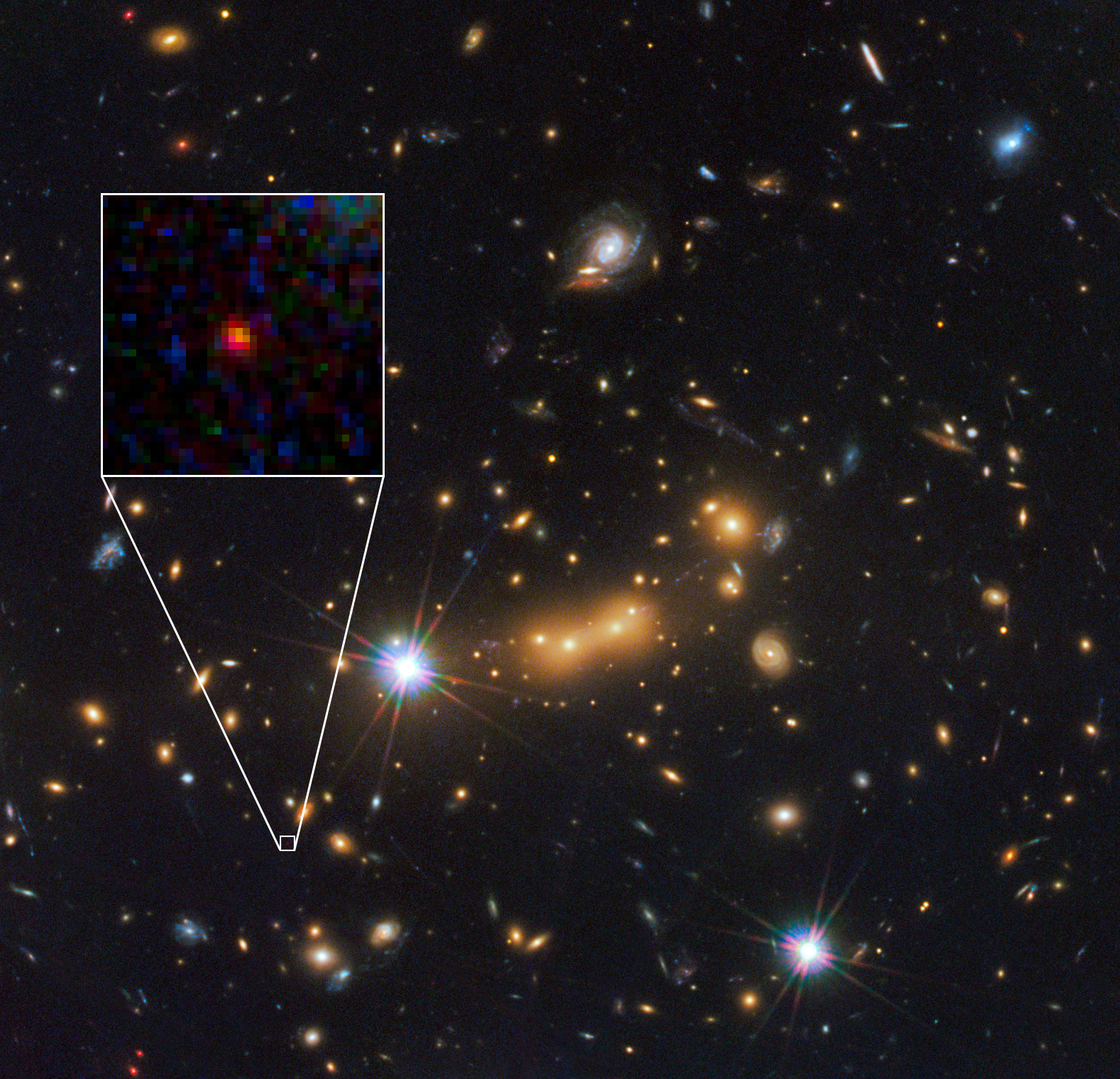MACS0647-JD on:
[Wikipedia]
[Google]
[Amazon]
__NOTOC__
MACS0647-JD is a 
NASA Great Observatories Find Candidate for Most Distant Object in the Universe to Date
*
Galaxy cluster MACS J0647.7+7015
{{DEFAULTSORT:MACS0647-JD Galaxies Camelopardalis (constellation) Dwarf galaxies
galaxy
A galaxy is a system of stars, stellar remnants, interstellar gas, dust, dark matter, bound together by gravity. The word is derived from the Greek ' (), literally 'milky', a reference to the Milky Way galaxy that contains the Solar System. ...
with a redshift
In physics, a redshift is an increase in the wavelength, and corresponding decrease in the frequency and photon energy, of electromagnetic radiation (such as light). The opposite change, a decrease in wavelength and simultaneous increase in f ...
of about ''z'' = 10.7, equivalent to a light travel distance of 13.26 billion light-year
A light-year, alternatively spelled light year, is a large unit of length used to express astronomical distances and is equivalent to about 9.46 trillion kilometers (), or 5.88 trillion miles ().One trillion here is taken to be 1012 ...
s (4 billion parsec
The parsec (symbol: pc) is a unit of length used to measure the large distances to astronomical objects outside the Solar System, approximately equal to or (au), i.e. . The parsec unit is obtained by the use of parallax and trigonometry, and ...
s). If the distance estimate is correct, it formed about 427 million years after the Big Bang
The Big Bang event is a physical theory that describes how the universe expanded from an initial state of high density and temperature. Various cosmological models of the Big Bang explain the evolution of the observable universe from the ...
.
Details
JD refers to ''J-band Dropout'' – the galaxy was not detected in the so-called J-band (F125W), nor in 14 bluer Hubble filters. It only appeared in the two reddest filters (F140W and F160W). It is less than 600 light-years wide, and contains roughly a billion stars. The galaxy was discovered with the help of Cluster Lensing And Supernova survey with Hubble (CLASH), which uses massivegalaxy cluster
A galaxy cluster, or a cluster of galaxies, is a structure that consists of anywhere from hundreds to thousands of galaxies that are bound together by gravity, with typical masses ranging from 1014 to 1015 solar masses. They are the second-l ...
s as cosmic telescopes to magnify distant galaxies behind them, an effect called gravitational lensing
A gravitational lens is a distribution of matter (such as a galaxy cluster, cluster of galaxies) between a distant light source and an observer that is capable of bending the light from the source as the light travels toward the observer. This ...
. Observations were recorded by the Wide Field Camera 3
The Wide Field Camera 3 (WFC3) is the Hubble Space Telescope's last and most technologically advanced instrument to take images in the visible spectrum. It was installed as a replacement for the Wide Field and Planetary Camera 2 during the first s ...
on the Hubble Space Telescope
The Hubble Space Telescope (often referred to as HST or Hubble) is a space telescope that was launched into low Earth orbit in 1990 and remains in operation. It was not the first space telescope, but it is one of the largest and most versa ...
, with support from Spitzer Space Telescope
The Spitzer Space Telescope, formerly the Space Infrared Telescope Facility (SIRTF), was an infrared space telescope launched in 2003. Operations ended on 30 January 2020. Spitzer was the third space telescope dedicated to infrared astronomy, f ...
.
The location of the galaxy is in the constellation Camelopardalis
Camelopardalis is a large but faint constellation of the northern sky representing a giraffe. The constellation was introduced in 1612 or 1613 by Petrus Plancius. Some older astronomy books give Camelopardalus or Camelopardus as alternative for ...
, which is also the location of the gravitational lensing cluster that helped discover this galaxy: MACSJ0647+7015 at ''z'' = 0.591.
MACS0647-JD was announced in November 2012, but by the next month UDFj-39546284
__NOTOC__
UDFj-39546284 is a high- redshift Lyman-break galaxy discovered by the Hubble Space Telescope in infrared Hubble Ultra-Deep Field (HUDF) observations in 2009. The object, located in the Fornax constellation, was identified by G. Illi ...
, which was previously thought to be ''z'' = 10.3, was said to be at ''z'' = 11.9, although more recent analyses have suggested the latter is likely to be at a lower redshift.
Infrared NIRCam
NIRCam (Near-InfraRed Camera) is an instrument aboard the James Webb Space Telescope. It has two major tasks, as an imager from 0.6 to 5 micron wavelength, and as a wavefront sensor to keep the 18-section mirrors functioning as one. In other wor ...
imaging of MACS0647-JD by the James Webb Space Telescope
The James Webb Space Telescope (JWST) is a space telescope which conducts infrared astronomy. As the largest optical telescope in space, its high resolution and sensitivity allow it to view objects too old, distant, or faint for the Hubble Spa ...
(JWST) in September 2022 determined a photometric redshift of , in agreement with the previous Hubble estimate. Additional spectroscopic observations by JWST will be needed to accurately confirm the redshift of MACS0647-JD.
See also
*List of the most distant astronomical objects
This article documents the most distant astronomical objects discovered and verified so far, and the time periods in which they were so classified.
For comparisons with the light travel distance of the astronomical objects listed below, the age of ...
* Farthest galaxies
References
External links
*NASA Great Observatories Find Candidate for Most Distant Object in the Universe to Date
*
European Space Agency
, owners =
, headquarters = Paris, ĂŽle-de-France, France
, coordinates =
, spaceport = Guiana Space Centre
, seal = File:ESA emblem seal.png
, seal_size = 130px
, image = Views in the Main Control Room (1205 ...
â€Galaxy cluster MACS J0647.7+7015
{{DEFAULTSORT:MACS0647-JD Galaxies Camelopardalis (constellation) Dwarf galaxies